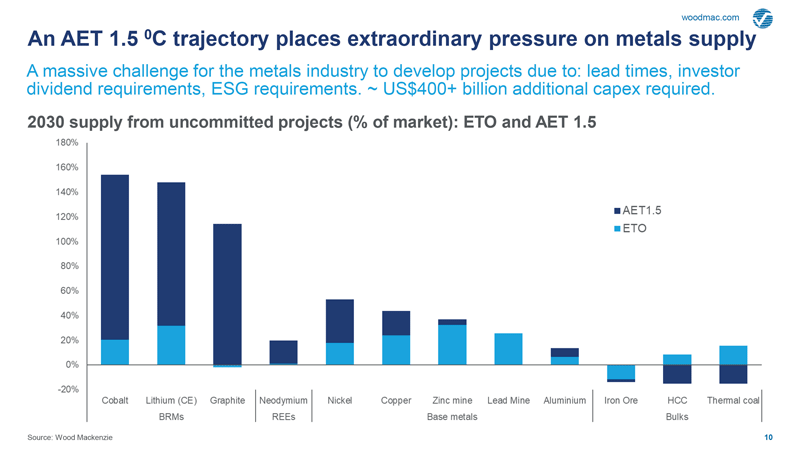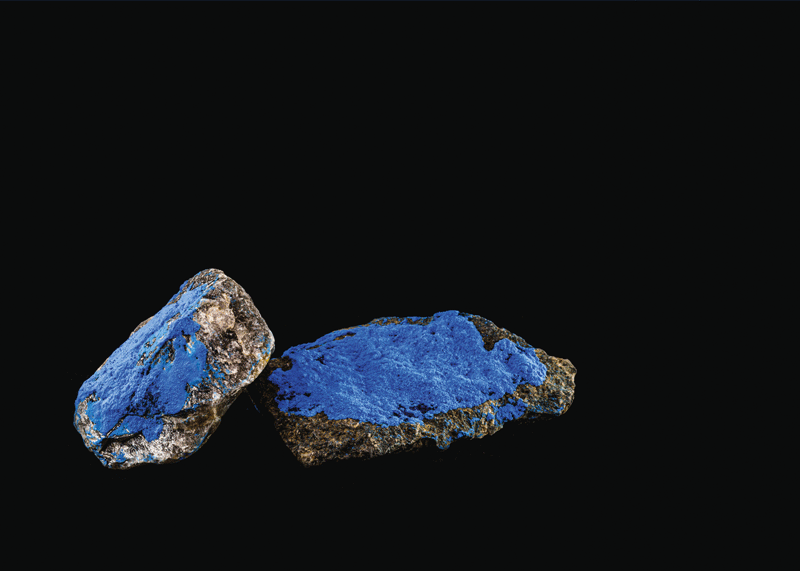Metal madness – exploring the commodities supercycle
Metal prices have soared over the past year with some commentators suggesting we are witnessing the beginning of a commodities supercycle. Alex Brinded investigates four of the metals that are seeing growing demand.

Global supply chains continue to struggle with COVID-19 related issues, with many countries still experiencing waves in rising cases, as well as restrictions, depleted workforces in some sectors and additional rules stifling trade.
Furthermore, a war in Europe combined with sanctions are also squeezing some commodities, with energy security a dilemma for an interlinked continent that depends on its neighbours to keep the lights on and factories operating. This is on top of the ripples from the Evergreen cargo ship that was recently stuck in the Suez Canal – and for the UK and its partners, the impact of Brexit.
Amidst this volatile backdrop, countries around the world have made net-zero pledges with roadmaps of reduced emissions targets. Industry has been given clear signals that the world wants to pivot away from a fossil-fuel-based economy.
The transition requires battery metals, wind turbines and solar panels, new and more efficient planes, ships and trains, and updated infrastructure such as heat pumps, electric cables and hydrogen storage. All require large quantities of metals and processing, and it means we need to move full steam (or should that be full wattage) ahead, but at what price?
Are we in a supercycle?
Robin Griffin, Vice-President of Metals & Mining at consultancy Wood Mackenzie, UK, spoke at the firm’s recent ‘Future Facing Mined Commodities Forum 2022’. He said that apart from iron ore and thermal coal, there are positive demand outlooks across the metals and mining sectors. ‘I think you would have to be living under a rock not to realise that prices have been extraordinarily strong, and they exploded into 2022 after a very solid 2021. Essentially, now we have got base metals at somewhere between 30 and 60% above where they were pre-pandemic. For battery raw materials, it is more like 300 or 500% above where they were, and even bulk metals have been joining the party at 2.5-3.5 times where they were.
‘But on top of the undoubtedly energy transition premium that is being paid, there are things like the pent-up demand from the pandemic, hugely stimulated economy, a lot of restocking, some hoarding, [and] supply chain issues which have lingered even while the recovery has taken hold, that have really supercharged pricing.’
He continues, ‘The types of growth [in demand] we are going to see to 2030 we think [are] 50% for lead and zinc, about 20% for copper and aluminium, just below 40% for nickel, and then 70 or 80% for the rare earths and graphite, and essentially a tripling of the lithium market. That kind of growth we think is going to create some major challenges for miners, remembering that this is under our base case.
‘Certainly, we do not think there are enough committed projects in the pipeline to actually meet the demand that I just laid out. We are talking big numbers. We are talking 5Mt of aluminium [for which] additional commitments need to be made, 5Mt for copper, 400,000t for lithium and 40,000t for cobalt.
‘Investment needs to ramp up and we are looking at about US$200bln of additional investment that would get us to where we need to be.’
Wood Mackenzie’s forecasting ramps up further when considering the accelerated energy transition required so the global temperature stays below a 1.5°C rise. Griffin says, in this scenario, ‘you need to actually go net-negative in terms of energy emissions by 2050. And you are looking at about 25% reduction in emissions by 2030.
‘You [need to] double the extra investment you need in aluminium, so you go from 5-10Mt, copper is 5-9Mt, nickel is an extra 1.7Mt. Obviously, lithium and cobalt need tripling, quadrupling of supply markets under this case. The investment requirement to get to this point we think is going to be over US$400bln.’
Copper
As we move towards electrification and battery storage, copper will be key. Over the past three decades, however, mining output for copper grew far slower than most other metals, rising just 123%, while aluminium grew 256% and iron ore 257%. Copper supply has grown less than 2% a year since 2013, reports the US Geological Survey.
According to the financial derivates exchange firm, the CME Group, USA, this is due to prices falling by more than half between 2010 and 2016, reaching near-production levels of value, which discouraged investment in new mines and ore processing. Also, the extraction cost has increased due to the greater energy expended to acquire the same weight of mineral.
In the past two years, however, copper prices have risen 125% since March 2020, with high energy prices boosting copper demand, alongside sales of electric vehicles (EV) surging by 160% in 2021, reports the CME Group. Although that is still only less than 4% of total vehicle sales, EV prices are decreasing and likely to further stimulate sales.
China alone buys 40%-50% of newly mined copper every year, with the price increase correlating to China’s GDP growth rate. Russia’s invasion of Ukraine has also had an impact, as supply has been dented. Russia produced 850,000t of copper last year, about 5% of the world’s total.
Nick Pickens, Research Director of Copper Markets for Wood Mackenzie, also speaking at the aforementioned webinar, says, ‘We can see that nearly two-thirds of global demand growth will go into the build-out of the global electrical network for transport. And the bulk of this, around 40% over the next 20 years, really relates to greener end-uses that are going to help fulfil the world’s decarbonisation needs and meet climate change targets.
‘By far the biggest single requirement is from EVs and the related charging infrastructure – just over 6Mt of incremental demand growth, and the majority, perhaps three-quarters of this demand, is in the form of battery foil.
‘Even larger copper-consuming countries still have some way to go before we might describe them as being in peak demand.’
Lithium
The global lithium prices compiled by Benchmark Minerals Intelligence, UK, have surged almost 490% in the past year. Even Elon Musk is getting in on the action, recently showing his hand with a look to mine the metal.
Daisy Jenner, a Lithium Analyst at Benchmark, explains the price rises. ‘The main drivers are essentially…structural tightness…in the lithium market. There was a similar price rally a couple of years ago, [but] it didn’t reach anywhere near the levels that we have reached now.
‘What we have seen in the last year and a half and looking forward what we are expecting to get worse, is an actual structural deficit for the lithium chemicals that could go into batteries for EVs or for energy storage. So there just isn’t enough material coming online to meet the downstream demand.’
Gavin Montgomery, Research Director of Battery Raw Materials at Wood Mackenzie, echoes this view, ‘The lithium market, I think, is 500,000t, or thereabouts, the cobalt market is 150,000t, or thereabouts. They are very small markets compared to the base metals of steel or iron or anything else.
‘Lithium prices were very high back in 2017-18, which induced a lot of new supply to come into the market. That then swamped prices and then prices were very low from 2019-20. So, there were operations that were idled in Australia, so forth, and now those are being fast-tracked to restart. So, it’s not like there is not supply there, some of it was shut down because the market was in such dire straits.’
Electric vehicle sales grew by nearly 190% in China in 2021. The country is also the single biggest source of copper demand for the past 20 years.
Source: CME Group
The problem is, he says, ‘it is 2022 now and it takes six to seven years to bring on a mine. In our pipeline, we just don’t see enough supply being invested in at the minute to really meet the forecast demand. That is where we see things started to get a bit trickier, and that is probably when you see this kind of multi-year boom, high prices and a battery raw materials bonanza’.
He continues, ‘Even relatively early in the energy transition, when there are not [even] a lot of EVs around relatively, lithium prices are going through the roof. Where we see the challenges is when we get to the 2027-28 period, towards the end of the decade, because that is when you are really starting to see EVs take off.’
Jenner reflects on the pandemic’s impact. ‘I think a lot of automakers had time to step back and say, this is the time now to transition into green energy, to really ramp up what we are doing with all EVs and those production lines. And demand for EVs has just surged. I think pretty much every month last year in China, EV sales and production broke another record.’
She adds, ‘Projects [are] coming online, but there is not the amount of supply to meet where the demand expectations are going, so year-on-year, we are expecting the deficit to widen towards the middle of the decade now.
‘There is no shortage of lithium in the ground, there is a shortage of investment projects and financing to get it out of the ground and refine it into the chemicals that it needs to go into factories.’

Nickel
Over the last five years, nickel prices have tracked below US$20,000/t, before going over in early Autumn 2021, and then exploding at the beginning of 2022 with extreme volatility. Nickel has been one of the most high-profile commodities to be hit by the war in Ukraine. According to S&P Global, Russia accounted for over 15% of global class 1 nickel output in 2021. The London Metals Exchange even suspended trading in early March this year in response to the three-month spot nickel price reaching an all-time high of US$101,365/t, before trading was resumed a week later with a phase-out of daily limits.
Regarding nickel, Montgomery explains that 65-70% is used in stainless steel, ‘but the big driver over the next 10-20 years is going to be the battery sector again, because nickel provides energy density, which means range to EVs. So, the move over the last few years has been to batteries with a higher nickel content.
‘The thing is in Europe…there is not a lot of nickel suppliers. Nornickel is one of the biggest there is, [but there are] not a lot of companies in Europe actually producing the cathodes for the batteries.
‘The scale of plants being built in Indonesia is quite astounding. I think there’s about 20 plants under planning which are going to produce nickel and cobalt for batteries in Indonesia.’
Greg Miller, a Nickel Analyst at Benchmark Minerals Intelligence, says, ‘A key part of the nickel story is…whether it is going to be the right type of nickel that meets your environmental standards. Because for mining in Indonesia, a lot of it is clearing rainforest [and] it is then dealing with the tailings associated with mining…Indonesia is very prone to seismic activity, so that is a risk.’
Again, China seems to be the only story for growth and development in the market. ‘We are not seeing the growth in non-Chinese owned assets,’ notes Miller.
‘Last year, we had total nickel supply at around 2.5Mt…So, it is just a fundamentally bigger market [than lithium]. They are similar in terms of the growth of the right supply [for] the battery industry being an issue, [but] the lithium and nickel markets are at different stages – the scale and also how easy it is to trade. The concern really does centre around nickel that meets the standards for Western original equipment manufacturers (OEMs) and self-producers.’

Cobalt
On the specifics of cobalt pricing, Montgomery says, ‘Cobalt has been used in consumer electronics for a long time. You are talking about a few grammes in a laptop perhaps, and now you are talking about 10-15kg of cobalt required in an EV. So, it is just the scale of that.’
Miller adds, ‘With cobalt you saw prices really spike in 2018, on the back of hype around the EV industry, and then prices crashed because the actual fundamentals were not there – the demand was not actually real yet. So, we saw prices crash from 2018. But since the second half of last year, we have seen a big rally in cobalt prices.’
He notes, ‘It is a similar story to nickel. I think a lot of the recent price spike is also down to just this disruption to supply chains globally...[And] Even though there is a lot of talk about thrifting cobalt out of the battery cell with the growth of LFP [lithium iron phosphate battery] utilisation, absolute cobalt demand is going to still increase.
‘We have seen a big growth in LFP production in China last year, but we still think that the high-nickel battery chemistries are going to be the dominant chemistry in Europe and North America.
‘Also, as demand continues to grow and really outpaces expectations, I think we will see a diversification of battery chemistry, as where NMC [lithium-nickel-manganese-cobalt-oxide] may service the higher end of the EV market, or also may be the primary in the European and North American industries and markets, we may have other chemistries to service the lower end portion of the market.’
Montgomery explains why cobalt is being phased out of batteries, citing its instability and contribution to overheating. ‘There are a lot of issues around cobalt, the fact that a lot of it is sourced from the Congo and the environmental, social and governance factors there. Most sailmakers and automakers have been trying to increase the nickel and decrease the cobalt ratio in the battery, which gives you more energy density, more range and, obviously, reduces the risk attached to cobalt.
China’s dominance
For now, China is locking up battery metal growth, observes Montgomery. ‘In terms of China being the major influence, it is already and it will continue to be for the foreseeable future, but I do not think that is necessarily unique to battery metals…the rest of the world will probably have to suffer being linked to those dynamics in some form or other.’
‘We refer to the Chinese market as a bellwether for the international market,’ says Jenner. ‘Maybe you will always find that the rest of the market might be three or four months behind the Chinese price…but it will always eventually have an impact on the rest of the world, because of the way the contracts are tied to what is happening in the Chinese market.’
Most analysts seem to agree that battery technology is not going to fundamentally change at a commercial level any time soon. Montgomery explains, ‘Because of the time cycles involved in the qualification process that most OEMs need…it takes maybe a couple of years of testing and qualification for a new battery chemistry…Then OEMs are probably qualifying sales or technology for their 2025 models, and that car model will probably be in existence five-plus years to 2030. So, there are all these layers underpinning it.’
We go back to Griffin’s comments at the Wood Mackenzie forum for final thoughts. Are we in a supercycle? ‘Yes, but not quite. When you look beyond 2023 and you look to 2030 for instance, those sort of structural demand issues relating to the energy transition really start to have an effect.’

